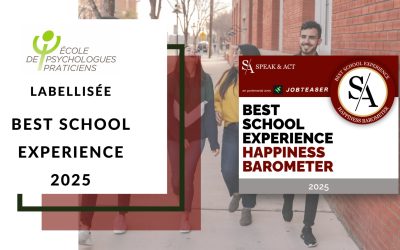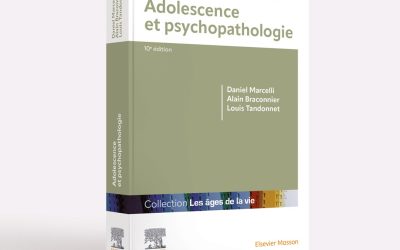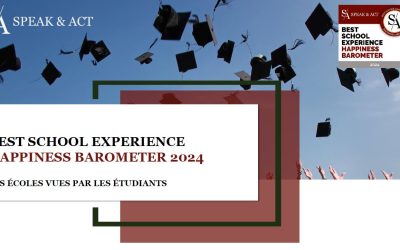Lettre d’information recherche 1 – Avril 2020

Lettre d’information recherche n°1
Avril 2020
Les membres de l’équipe de recherche Vulnérabilité, Capabilité et Rétablissement (VCR) de l’École contribuent à donner à l’établissement une visibilité nationale, voire internationale au plan de la recherche. Il est donc important que vous soyez informés de l’actualité qui concerne cette équipe qui a été formée. 8 enseignants chercheurs la constituent, sur Lyon et Paris, avec le soutien de nombreux chercheurs associés. Une partie des enseignements est fondée sur les travaux de recherche de ses membres. C’est donc une composante importante de l’École. Cela va vous permettre aussi d’identifier les champs de recherche de chacun des membres en ayant un aperçu des travaux qui sont réalisés. Ces informations seront régulières, au fil des publications acceptées. Elles sont bien-sûr accessibles auprès du premier auteur ou du membre de l’équipe VCR (en gras dans les références) que vous pouvez contacter. Il vous l’enverra par mail, n’hésitez pas à le solliciter. Deux de nos étudiantes ou anciennes étudiantes sont mises à l’honneur dans cette première lettre d’information consacrée à la recherche au sein de l’EPP. Elles viennent toutes les deux de l’EPP Lyon. Tout d’abord, Maévane Lavier, récompensée par le Prix Chartier l’an passé, encadrée par M. Tristan Le Chevanton, a publié les résultats de son travail de recherche. Ensuite, Marine Miglianico, inscrite en deuxième année de thèse à l’Université Trois-Rivières au Québec – Université de Lorraine à Metz (équipe EPSAM), encadrée en co-tutelle avec Philippe Dubreuil. Cela doit encourager les étudiants des 4ème et de 5ème années à s’inscrire dans cette logique. Même si tous ne publieront pas forcément, cela doit être un encouragement. C’est possible ! Les références vous données ainsi que les résumés et les mots clé de manière à ce que vous ayez quelques détails. Des indications sont données sur les revues support. Dans le principe, les différents indicateurs données sont en lien avec le nombre de fois où la revue est citée. Plus elle est citée, plus elle a des chances d’être référencée Q1 (premier quartile de citation et lecture dans le champ disciplinaire, Q2 second quartile, etc. jusqu’à Q4), et d’avoir un indice H et un facteur d’impact élevé. Quand il n’y a pas d’information, c’est souvent que la revue est récente et pas encore référencée. Ces informations sont accessibles sur le site SCIMAGO. A bientôt.
Charles Martin-Krumm
(Veuillez noter que l’ensemble des lettres de la recherche se trouvent sur notre site dans l’onglet RECHERCHE)
Lavier, M., Le Chevanton, T., & Béal, A. (2020). La transmission d’exploitation agricole, entre psychologie des représentations sociales et psychologie clinique. Une voie d’abord vers l’interdisciplinarité dans les méthodes de recherche qualitative. In Analysis, 4(1), 73-81. https://doi.org/10.1016/j.inan.2020.01.011
Résumé
Cet article s’inscrit dans l’usage de l’entretien semi-directif en recherche qualitative, sur la base de 15 entretiens réalisés lors d’un mémoire de recherche sur la transmission d’exploitation agricole. Objectifs : Les propos visent à montrer l’intérêt et les limites du positionnement clinique pour répondre à une problématique aux confins de la psychologie clinique et de la psychologie des représentations sociales. Méthode : En repartant de la discussion qui a ordonné la conduite de cette étude, les auteurs présentent leur réflexion, sur la base de leurs interrogations et rencontres avec le milieu agricole. Résultats : Les résultats montrent la manière dont l’entretien semi-directif en recherche qualitative en psychologie sociale est enrichi par un positionnement clinique. Ce type particulier de recherche permet de révéler des enjeux individuels et sociaux, tout en restant aux prises à certains clivages. Toutefois, cette approche est intéressante pour saisir le fantasme d’immortalité du groupe agricole, véhiculé par les représentations sociales de la transmission d’exploitation ; et sa rencontre avec le principe de réalité illustré par la vulnérabilité de la profession.
Mots clés : Méthodologies qualitatives de recherche, Psychologie clinique, Psychologie des représentations sociales, Transmission, Agriculture
Plantade-Gipch, A., Drouin, M.-S., & Blanchet, A. (In press). Can alliance-focused supervision help improve emotional involvement and collaboration between client and therapist? European Journal of Psychotherapy and Counselling. Q4 – H factor 10 – Impact Factor .18
Résumé
As research has shown a consistent link between the alliance and the therapeutic success, an alliance-focused supervision was designed to help novice therapists improve their relational and collaborative abilities. Fifteen young therapists participated in the alliance-focused supervision and 15 did not. Therapists’ and clients’ results at the Working Alliance Inventory showed that the supervision model improved their perceptions concerning the therapist’s ability to foster mutual emotional involvement, as well as collaboration in therapeutic work. All therapists demonstrated an ability to negotiate emotional alliance with the client. However, when they participated in the alliance-focused supervision, they appeared to improve their capacity to finding an agreement with the client around therapeutic goals, which was not the case when they did not participate in supervision. In addition, more independent views on the alliance appeared in clients and therapists when the professional took part in the alliance-focused supervision than when he/she did not. Results on the Difficulties in Emotion Regulation Scale also showed that participating in the alliance-focused supervision had a protective influence on therapists’ impulsiveness. Overall, alliance-focused supervision appeared useful in helping therapists improve emotional involvement and collaboration in the alliance with the patient. It also seemed to protect them from being impulsive.
Keywords: Therapeutic alliance; Therapist’s reflexivity; Therapist’s relational abilities; Clinical supervision.
Gauvin, G., Labelle, R., Daigle, M., Breton, J.J. & Houle, J. (in press). Psychological factors strengthening homeless youths’ life satisfaction. Journal of Social Distress and the Homeless. 10.1080/10530789.2020.1761099 Q2/Q3 – H factor 18 – Impact Factor .38
Abstract
Life satisfaction among homeless youth is particularly low, yet remains a poorly investigated phenomenon. This study aims to explore three positive psychological factors related to homeless youth’s life satisfaction: coping strategies, self-esteem, and social support. Seventy-four homeless adolescents from eight different shelters in Quebec (Canada) were interviewed to fill out self-report questionnaires. Multiple regression analysis revealed that coping strategies focused on solving the problem, positive self-esteem, and to worry less about the future contributed the most to homeless youths’ life satisfaction. These psychological variables contributed to life satisfaction after adjusting for a set of potential covariates: gender, sexual abuse, and mental health. In conclusion, improving homeless youths’ self-esteem, developing their capacity to actively solve their problems, and finding alternatives to unproductive worry seem to represent key components for enhancing homeless adolescents’ life satisfaction.
Key Words: Homeless youths, life satisfaction, self-esteem, coping strategies, social support.
Cognet, A., & Masson, C. (2019). Souviens-toi. Processus de deuil, processus de création. L’Évolution psychiatrique, 84 (2), 539-548. Q3 – H factor 12 – Impact Factor .30
| Résumé |
Objectifs : Les auteurs cherchent à mettre en lumière certains des mécanismes psychiques qui soutiennent une mise en sens de la mort, au travers, en particulier, d’objets à haute valeur symbolique comme liens entre les morts et les (sur)vivants. Méthode : Dans cet article clinique, de méthodologie heuristique, nous associerons l’analyse d’une situation clinique de mort anténatale, paradigmatique des deuils à risque pathologique, et celle de la création artistique du plasticien Michel Nedjar, en lien avec le génocide juif. Résultats : Le traitement psychique de la perte d’un être aimé est l’occasion d’un risque psychopathologique important. Si les rites funéraires (religieux ou laïques), le soutien des proches et de la communauté permettent, dans bien des cas, d’offrir aux endeuillés un cadre propice à l’accomplissement de processus de deuil suffisants pour continuer à vivre avec la perte (et non pas à vivre sans le disparu), certaines situations particulièrement traumatiques interdisent l’accès à un deuil non pathologique. Discussion : Les auteurs seront amenés à réinterroger l’exclusivité du modèle freudien de Deuil et Mélancolie et à s’appuyer sur le modèle théorique winnicottien des phénomènes transitionnels pour éclairer les processus psychiques à l’œuvre. Conclusions : La créativité à l’œuvre dans ces deux situations maintient une certaine distinction : sublimation du côté de l’artiste, résurgence des phénomènes transitionnels du côté de l’individu endeuillé.
Mots clés : Deuil, Création, Objet, Périnatalité, Objet transitionnel, Art
Plantade-Gipch, A. (2019). La supervision centrée sur l’alliance pour les psychologues praticiens. Vers un élargissement aux professionnels du soin et de l’éducation ? Présences, 12. Université du Québec à Trois-Rivières, https://www.uqar.ca/universite/a-propos-de-l-uqar/departements/departement-de-psychosociologie-et-travail-social/presences-revue-transdisciplinaire-d-etude-des-pratiques-psychosociales.
Résumé
Cet article présente un modèle de supervision visant à soutenir et à développer les capacités réflexives des professionnels dans la relation à l’usager. Il présente les résultats des entretiens de recherche d’une étude sur la supervision centrée sur l’alliance thérapeutique conduite auprès de jeunes psychologues. Il argumente un possible élargissement de l’utilisation du dispositif de supervision centré sur l’alliance à d’autres professionnels du soin et de l’éducation.
Mots-clés : supervision, alliance thérapeutique et didactique, réflexivité des professionnels.
Gaspar de Matos, M., Wainwright, T., Brebels, L., Craciun, B., Gabrhelík, R., Hjartnes Schjodt, B., Plantade-Gipch, A., Poštuvan, V., Stojadinovic, I., & Richards, J. (2019). Looking Ahead: Challenges and Opportunities for Applied Psychology in Prevention and Promotion. European Psychologist. doi: 10.1027/1016-9040/a000362. Q2 – H factor 48 – Impact Factor .88
Abstract
Across many domains of health and welfare, there have been remarkable advances in prevention where public-health models have had a significant impact. Psychology has much to offer in building on these successes and we describe some excellent examples, but in general, it has not been fully engaged with prevention science and implementation. We set out some of the key challenges and opportunities for psychology and prevention science in contemporary practice, recognizing that often the rhetoric from governments to support prevention interventions do not match up to making the necessary resources available. We argue that psychology must prioritize this area of practice as there is evidence that the gains of recent decades may be under threat without concerted efforts. (PsycINFO Database Record (c) 2019 APA, all rights reserved)
Key words: applied psychology, behavioral economics, mental health, prevention and promotion sciences, public policies.
Le Chevanton, T., Fouques, D., Julien‐Sweerts, S., Petot, D., & Polosan, M. (2020). Differentiating unipolar and bipolar depression: Contribution of the Rorschach test (Comprehensive System). Journal of Clinical Psychology, 76(4), 769–777. https://doi.org/10.1002/jclp.22912 Q1 – H Factor 103 – Impact Factor 1.13
Abstract
Objective: The aim of this study was to contribute to differential diagnoses of unipolar and bipolar depression using cognitive variables of the Rorschach test (Comprehensive System). Method: One hundred forty-one depressed inpatients (71 bipolar, 70 unipolar; mean age = 46, SD = 15.8; 64% women) previously evaluated and comparable regarding clinical characteristics of their illness (including current mood symptoms) were blindly tested using the Rorschach test (C.S.). Results: The cognitive profile of bipolar depressed patients was more impaired than the cognitive profile of unipolar depressed patients. Combining four cognitive specificities (tolerance to ambiguity, discrimination failure, difficulties in controlling ideational impulses, and impulsive or negligent processing) in a logistic regression model allows the identification of bipolarity with acceptable accuracy. Conclusions: Some aspects of cognitive functioning, as assessed with the Rorschach test (CS), appear to be useful to capture some important cognitive specificities of bipolar depression and could contribute to differential diagnoses of mood disorders.
Keywords: bipolar disorder; cognitive impairment; depression; differential diagnosis; Rorschach test (CS); thought disorders; unipolar disorder
Babeau, C., Le Chevanton, T., Julien-Sweerts, S., Brochenin, A., Donini, L. M., & Fouques, D. (2019). Structural validation of the ORTO-12-FR questionnaire among a French sample as a first attempt to assess orthorexia nervosa in France. Eating and Weight Disorders – Studies on Anorexia, Bulimia and Obesity. https://doi.org/10.1007/s40519-019-00835-0
Abstract
Purpose: To the best of our knowledge, no scientific publications on orthorexia nervosa have been based on a French population. The goal of our study was to confirm the factor structure of the French version of the ORTO-15 questionnaire. Methods: An online survey (N = 768) was conducted asking participants (84.77% were women) to answer several questions about their dietary habits and to assess orthorexia nervosa using the ORTO-15 scale. Confirmatory factor analysis (CFA) was used for the validation. Results: Given our results, we deemed it necessary to adapt the French version of the ORTO-15 questionnaire by omitting three items. The CFA supported the ORTO-12-FR (composed of 12 items and addressing three domains: rational, emotional, and behavioral) as the better-fitting model, with an internal consistency of 0.73. The Comparative Fit Index value was 0.93, the Tucker–Lewis Index was 0.90, and the Root Mean-Square Error of Approximation was 0.05. Conclusions: Our results provide evidence for the reliability of ORTO-12-FR with a French population.
Keywords: Orthorexia nervosa; Eating habits; Behavioral addiction; Orto-15; Orto-12-FR
Heintz, S.,Ruch, W., Aykan, S., Brdar, I., Brzozowska, D., Carretero-Dios, H., Chen, H.-C., Chłopicki, W., Choi, I., Dionigi, A., Ďurka, R., Ford, T. E., Güsewell, A.,Isler, R. B., Ivanova, A., Laineste, L., Lajčiaková, P., Lau, C., Lee, M., Măda, S., Martin-Krumm, C., Mendiburo-Seguel, A., Migiwa, I., Mustaf, N., Oshio, A., Platt, T., Proyer, R. T., Quiroga-Garza, A., Ramis, T., Săftoiu, R., Saklofske, D. H., Shcherbakova, O. V., Slezackova, A., Stalikas, A., Stokenberga, I, Torres-Marín, J., & Wong, P. S. O. (2019). Benevolent and corrective humor, life satisfaction, and broad humor dimensions: Extending the nomological network of the BenCor across 25 countries. Journal of Hapiness Studies. https://doi.org/10.1007/s10902-019-00185-9 Q1 – H factor 57 – Impact Factor 1.909
Abstract
Benevolent and corrective humor are two comic styles that have been related to virtue, morality, and character strengths. A previous study also supported the viability of measuring these two styles with the BenCor in 22 countries. The present study extends the previous one by including further countries (a total of 25 countries in 29 samples with N = 7813), by testing the revised BenCor (BenCor-R), and by adding two criterion measures to assess life satisfaction and four broad humor dimensions (social fun/entertaining humor, mockery, humor ineptness, and cognitive/reflective humor). As expected, the BenCor-R showed mostly promising psychometric properties (internal consistency and factorial validity). Consistent with previous studies, benevolent humor correlated positively with life satisfaction in most countries, while corrective humor was uncorrelated with life satisfaction. These relationships were only slightly changed when controlling for social fun/entertaining humor and mockery, respectively. Benevolent humor was mostly positively associated with cognitive/reflective humor, followed by social fun/entertaining humor and mockery. Corrective humor was mostly positively associated with mockery, followed by cognitive/ reflective and social fun/entertaining humor, although these relationships differed between the countries. Overall, the present study supports the viability of benevolent and corrective humor, which has yet received insufficient attention in psychology, for cross-cultural investigations and applications of humor, well-being, and morality.
Keywords: Humor · Life satisfaction · Cross-cultural comparisons · BenCor
Van Hoye, A., Omorou, Y., Gendarme, S., Tarquinio, C., Houtmann, B., Peiffert, D., Longo, R., & Martin-Krumm, C. (2019). Psychological and social determinants of physical activity from diagnosis to remission among French Cancer patients (PERTINENCE): protocol for a mixed-method study. BMC Public Health. Q1 – H factor 117 – IF. 1.38
Abstract
Background: Many effective physical activity (PA) interventions have focused on individual factors or a single theoretical model, limiting our understanding of the determinants of PA practice and their interactions in the cancer trajectory. The present mixed-method study aims to capture social and psychological determinants of PA practice from diagnosis to remission among cancer patients, and to identify key levers for PA practice. Methods/design: A nested sequential mixed-method design QUAN (QUAL+QUAL) will be used, with qualitative studies embedded in the quantitative study to broaden our understanding of the determinants of PA practice. The design is sequential, since qualitative data on medical staff will be collected before patient inclusion (Phase 1), followed by quantitative patient data collection lasting one year (Phase 2) and a final qualitative data collection one year after inclusion (Phase 3). Phase 1 will be a case study in the two hospitals involved in the study, exploring knowledge of and support for PA practice among medical staff. Through interviews and documental analyses, the PA support dynamic will be evaluated with regard to PA prescription. Phase 2 will be a one-year observational study among 693 cancer patients. Quantitative medical, social, dispositional and psychological data, PA practices and preferences, will be collected at diagnosis, and six months and one year thereafter. Phase 3 will be a retrospective study, evaluating societal and policy factors, as well as unexpected factors playing a role in PA levels and preferences among cancer patients. For this phase thirty patients will be identified six months after inclusion on the basis of their PA profiles. Quantitative data will provide the main dataset, whilst qualitative data will complete the picture, enabling determinants of PA practice and their interactions to be captured throughout the cancer trajectory. Discussion: The present study aims to identify key levers and typical trajectories for PA practice among cancer patients, adapted to different times in the course of cancer and taking into account “what works”, “for whom”, “where” and “how”. The challenge is the tailoring of PA interventions to patients at different times in their cancer trajectory, and the implication of medical staff support. Trial registration: Clinical Trial NCT03919149, 18 April 2019. Prospectively registered.
Keywords: Physical activity, Cancer, Socio-ecological model, Mixed method
Broc, G., Shankland, R., Carter, S., Martin-Krumm, C., & Bouteyre, E. (2019). Etude du burnout chez les étudiants doctorants. Annales Médico-Psychologiques. Doi: 10.1016/j.amp.2019.01.011 Q2/Q3 – H Factor 18 – IF. 0.221
Objectifs. L’épuisement académique est un problème majeur de santé publique, a fortiori chez les étudiants en thèse qui font figure de population particulièrement vulnérable au syndrome. Si un repérage précoce du burnout prévenait ses effets sur la santé mentale et la performance académique, la validation d’un tel instrument en langue française adapté aux particularités des doctorants resterait encore à établir. Matériel et Méthodes. La présente étude propose la validation d’une échelle d’épuisement académique doctorant (la MBI-SS-D) adaptée de la version française de la Maslach Burnout Inventory–Student Survey (MBI-SS). Pas moins de 1150 doctorants issus de plus d’une dizaine de cursus en France ont répondu au questionnaire en ligne. Ils étaient encore 862 au retest 6 mois plus tard. Résultats. Les analyses factorielles exploratoires et confirmatoires aux deux temps ont invariablement permis de retrouver la structure tridimensionnelle du burnout (épuisement émotionnel, cynisme, auto-efficacité académique). Les indices alpha et oméga proches de .80 et les coefficients split-half entre .70 et .89 renforçaient cette observation. Par ailleurs, les tests d’invariance métrique et structurale prouvaient la grande stabilité test-retest du MBI-SS-D jusqu’au critère le plus strict. Concernant la validité divergente, la mesure du burnout était liée négativement avec aussi bien l’optimisme (rs= –.41 ; p<.001) que la résilience (rs= –.32 ; p<.001). Conclusions. Le MBI-SS-D démontre de réelles qualités psychométriques. Il constitue à l’heure actuelle le seul outil en langue française permettant une mesure valide de l’épuisement académique à des fins de recherche ou de pratique clinique chez les doctorants.
Mots-clefs : burnout ; doctorants ; MBI ; validation ; repérage clinique
Miglianico, M., Dubreuil, P., Miquelon, P., Bakker, A., & Martin-Krumm, C. (2019). Strength Identification and Development in Organizations: A Literature Review. Journal of Happiness Studies. doi.org/10.1007/s10902-019-00095-w Q1 – H factor 57 – Impact Factor 1.909
Abstract
The objective of the present article is to review the literature on strengths use and development in the workplace. This review (1) presents a summary of the outcomes of strengths use in organizations, and (2) proposes a general intervention model facilitating strengths development in the workplace. A systematic review was used to summarize the outcomes of studies on strengths use at work, whereas a narrative review was employed to examine the main strengths development interventions available, and to propose an integrative model. Results indicate that strengths use is associated with job satisfaction, work engagement, well-being, and work performance. Furthermore, scholars and professionals use similar intervention strategies that can be summarized in a five-step integrative model to promote strengths development in organizations. We discuss the theoretical and practical implications, as well as avenues for future research.
Keywords: Strengths; Organizations; Intervention; Positive Psychology






